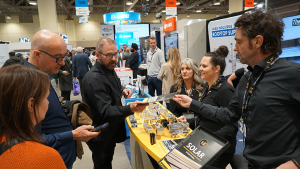Billed as the largest smart building conversion to advance energy conservation and sustainability in North America, a project by a Hamilton, Ont.-based energy conservation company transformed 13.3 million square feet in 85 multi-residential buildings in southwestern Ontario.
The 10,000-suite project is on track to achieving a 16 per cent investment return primarily through utility bill reductions, exceeding the owner’s expectations of 12 per cent.
“We’ve eliminated 3.1 kWh of electricity and 1.3 million cubic metres of natural gas totalling a 36 per cent reduction on greenhouse gas emissions even before we have done any fuel switching,” Josh Lewis, vice-president of energy engineering with Nerva Energy Group Inc. told a seminar on the project at The Buildings Show 2024 recently in Toronto.
“Obviously it is a great news story from an environmental perspective,” he said, noting the project, which commenced in 2023, was completed in “only 10 months.”
Owned by Drewlo Lifestyle Apartments, the buildings are in various conditions and date from the 1970s to the 2000s. They are in London, Sarnia, Woodstock, Kitchener and Burlington.

Lewis said the project included mechanical optimization of boilers, chillers, cooling towers and makeup air and fresh air delivery to units.
He added in the average rental building, 10 per cent or less of the tenants are responsible for 40 per cent of the heating and cooling simply through the misuse of windows and doors.
“They typically are leaving their windows open 24/7, 365 days a year and cranking their heating and cooling.”
The project’s solution was to install sensors in windows and doors to alert building management.
Overall, real time energy performance reporting “is uncanny different from where these buildings operated before,” he told the seminar audience.
Lewis said while the project is saving millions of dollars annually in utility bills, the net asset value of the buildings increased by about $33 million.
He told the audience that optimization of equipment, rather than equipment conversion or fuel switching, is the best starting point to improving a building’s energy performance “because we have to get the waste out first.”
“We’re finding additional opportunities in the buildings even though we’ve driven out most of the waste already,” he added.
The ability to access space condition data quickly from buildings through Internet of Things technologies was one of the keys to creating “energy performance dashboards” in real time on the project.
Nerva has received numerous awards for the 85-building project, including the energy project of the year in Canada from the Association of Energy Engineers and it made the list of the Clean50 top projects, which recognizes companies for sustainability and clean capitalism in Canada. It is the second time in four years Nerva has made Clean50’s list.
Lewis said the project’s buildings have moved to second phase improvements that include determining what equipment should be replaced for operational efficiency through data analysis.
“It’s getting us to a point of a cost-effective transition away from fossil fuels.”
Nerva has also worked with Drewlo on three buildings to be completed next year that will have ground source heat pump systems aimed at meeting 90 to 95 per cent of the heating demand.
“The lifecycle costs of ground source heat pump systems have crossed the Rubicon in terms of a 20 to 30-year life cycle cost,” he added.
Solar photo-voltaic systems on rooftops and above parking garages are also in play, he said.
Lewis said data from hundreds of MURBS analyzed by Nerva shows they have upwards of 50 per cent energy waste.
“What we’ve shown through this case study is you can eliminate this waste while achieving positive returns.
“The price on carbon is not going away,” he adds, “so if we don’t start making the choices to move forward we’re going to end up in a spot where our operating expenses five, 10, 15 years down the road are out of control.”





Recent Comments
comments for this post are closed